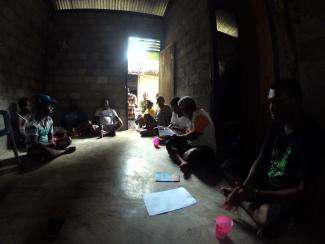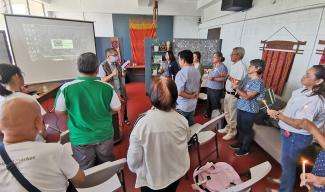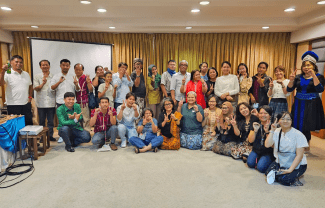It took more than two hours by boat, through a driving rain, to reach the village of Saubeba from the nearest large town of Sausapor in Indonesia's West Papua province. There, locals had gathered to discuss a government-backed plan to designate Tambrauw district, of which Saubeba is a part, a conservation zone.
On paper, at least, this would seem a no-brainer: 80 percent of the district's nearly 11,400 square kilometers (4,400 square miles) is lush forest that falls within existing conservation or protected areas; its coast is a hatching ground for the rare leatherback sea turtle (Dermochelys coriacea), and its rainforests home to exotic birds-of-paradise (family: Paradisaeidae).
The idea to officially designate the entire district a conservation zone came in 2011, following the election of Gabriel Asem as district chief. Tambrauw itself was only established in 2008, as part of the newly formed administrative province of West Papua.
Gathered in the downpour that November day in Saubeba, representatives of the various indigenous communities living in the area discussed with local authorities what the conservation designation would mean, not just for the district but also their way of life.
"Many of us here still don't understand what conservation means, it's still unfamiliar [to us]," said Bernadus Yewen, a community leader. "If it means protecting the forest, then we've been doing it since the time of our ancestors."
It was a sentiment widely shared by the others in attendance. In the end, Yewen said, the people of Saubeba fully supported the idea of a conservation district because their lives had always depended on the sustainable management of Tambrauw's rich natural resources.
The program comes amid a major infrastructure and economic development push 'which portends massive forest clearing' across the provinces of Papua and West Papua, as part of President Joko 'Jokowi' Widodo's efforts to boost Indonesia's underdeveloped eastern regions. Plantation companies are also increasingly targeting the Papua provinces, which share the world's third-largest span of rainforest with Papua New Guinea, to expand their concession after having nearly depleted the forests of Sumatra and Kalimantan, the Indonesian part of the island of Borneo.
A bill on the conservation district program is currently working its way through the district legislature, in tandem with a bill that would officially recognize the ethnic groups in Tambrauw and enshrine their civil rights in law.
Like many other indigenous rural communities in Indonesia, Papuan tribes have frequently clashed with the government or companies laying claim to their land, whether for public works projects or commercial development. These communities have nothing to back their claims to the land, and are in most cases forced out of their homes by those with greater political and legal power.
Yewen cited the case of a local timber company, PT Multi Wahana Wijaya, which has operated in Saubeba since 2004. The company, he said, had logging permits from the national and district governments, but none from the village's indigenous groups.
"The company logs our trees and ships them out of here and even abroad," he said.
Mesak Yekwam, the Tambrauw deputy district chief, who attended the gathering, vowed to look fully into the matter and resolve it. He suggested the company might have been illegally logging beyond its concession, and said his office could shut down its operations if it was found to have violated any regulations or failed to make a positive impact on the local community.
Yekwam also said resolving territorial conflicts between rival clans within the local ethnic groups was a top priority to get the conservation program and indigenous rights bills going.
"We must focus first on mapping out the customary lands," he said. "We also need to improve the relationship between clans and tribes."
Tambrauw is home to 156 clans from five ethnic groups. Inter-clan conflicts frequently erupt across Papua, but Saubeba has managed to avoid the problem, according to Yowel Yesnath, the village chief.
"We're pretty lucky that we never fight with each other about territory," he said. "We're ready to help other tribes and clans so we can protect our lands together."
Yekwam said his office hoped to get the conservation district and indigenous rights bills through the legislature by next year.
One anticipated outcome of all this is the prospect of developing an ecotourism industry based on the region's natural riches. Once the customary lands are mapped out, prime nature hotspots can be identified for ecotourism development, thereby helping boost the local economy, said Betwel Yekwam, a district tourism board official. He noted that Tambrauw had many sites perfect for birdwatching, diving and snorkeling.
He said, "We have many kinds of birds here, including the birds-of-paradise." Colorful avians that, fittingly enough, are a culturally revered species and also a beloved mascot for the Papua region.
This story was first published on mongabay.com on December 14, 2017.




